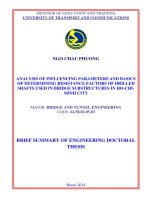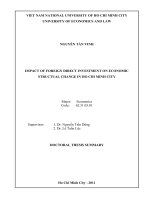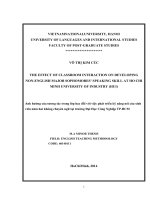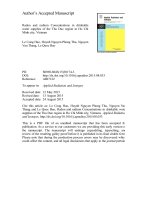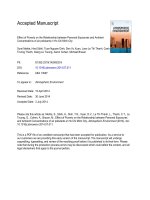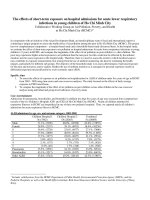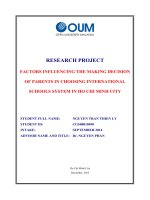FACTORS INFLUENCING THE EFFECTIVENESS OF TREASURY AND BUDGET MANAGEMENT INFORMATION SYSTEM (TABMIS) IN STATE TREASURIES IN HO CHI MINH CITY
Bạn đang xem bản rút gọn của tài liệu. Xem và tải ngay bản đầy đủ của tài liệu tại đây (687.55 KB, 12 trang )
<span class='text_page_counter'>(1)</span><div class='page_container' data-page=1>
FACTORS INFLUENCING THE EFFECTIVENESS OF TREASURY AND
BUDGET MANAGEMENT INFORMATION SYSTEM (TABMIS) IN
STATE TREASURIES IN HO CHI MINH CITY
NGUYEN THI THU HIEN 1<sub>,CO THI THANH HUONG</sub> 1<sub>, PHAM THI HONG NHUNG </sub>2<sub>, </sub>
PHAM TRUONG QUAN 1
1<sub> Faculty Accounting and Auditing, Industrial University of Ho Chi Minh city, </sub>
2<sub>School of Accounting and Auditing, University of Economics Ho Chi Minh city; </sub>
,
, ,
Abstract. Applying information technology to state budget management is one of the solutions to
improve transparency in public financial management, limit disadvantages in using budgets and ensure
financial security in the process of national development and integration. In particular, implementing the
treasury and budget management information system (TABMIS) is an important orientation in the
treasury development strategy by 2020 of the Ministry of Finance of Vietnam. This study aims to analyze
the critical factors affecting the effectiveness of TABMIS in state treasuries in Ho Chi Minh City. Using
quantitative research method, the findings reveal that key factors included top management commitment
and support; vendor support; implementation team; ERP user involvement; Data quality; infrastructure
quality; TABMIS software quality; The management policies of TABMIS system, monitoring and control
environment have a positive impact on the effectiveness of the TABMIS system, in which the monitoring
and control environment factor has the strongest impact.
Keywords. Management Information system, TABMIS, the effectiveness, state treasury, Budget
management.
1. INTRODUCTION
In the era of globalization along with the development of information technology, the deployment
and application of Enterprise Resource Management (ERP) system is essential because this system helps
organizations manage work effectively, quickly, provide timely and reliable information. Previous studies
showed that ERP project success brings many advantages for organizations including increasing financial
performance through efficient data processing, improving competitive position, and breaking down
barriers interfering between departments, making it easy to exchange important data. Therefore, many
countries have applied ERP business management software solutions in budget management to improve
transparency and effectively control budget operations.
There are several papers studied the application of public sector ERP systems and the factors
affecting system success (Ziemba and Oblak, 2013; Kalema BM et al., 2014). Omar MB & Rami
MAW (2016)analyzed the benefits of ERP application in Bahrain Kingdom public sector and key
success factors (KSFs) affect the system, including (1) top management commitment and support;(2)
ERP system matching organization;(3) business process re-engineering; (4) vendor support;(5) training
users.
</div>
<span class='text_page_counter'>(2)</span><div class='page_container' data-page=2>
Slovakia, Kenya, Uganda, Indonesia... and Vietnam with WB-funded Treasury and Budget Management
Information System (TABMIS) project, which has been implemented by the Ministry of Finance.
The TABMIS system has the function of supporting governmental accounting, which is important
part of the system of financial and economic management tools, operating and controlling state budget
activities.Therefore, in order to force the modernization reform process of the public finance sector as
well as to support the project of the consolidated financial statements for the general governmental
accounting, the effectiveness of the TABMIS system needs to be improved.Therefore, it is necessary to
identify the factors affecting the effectiveness of the TABMIS system but there is very little research
about TABMIS, and they mainly focus on qualitative research.Therefore, this study focused on
identifying and analyzing the factors affecting the effectiveness of the TABMIS system with the scope of
research being the State Treasury in HCM City.Research results will help the State Treasury evaluate the
effectiveness of TABMIS system to better manage the state budget revenue and expenditure, provide
reliable financial reports.The objectives of the study include two main topics: (1) Identify the factors
affecting the effectiveness of TABMIS system at the State Treasury in Ho Chi Minh City;(2) Test the
influence of factors on the effectiveness of the TAMIS system at the State Treasury in Ho Chi Minh City.
The remainder of the paper proceeds as follows. In the next section, we present an overview of past
literature and our hypotheses; in section „Institutional background‟, we provide institutional background;
in Section „Sample and variable construction‟ we present our sample and provide some descriptive
statistics; in Section „Research design‟, we describe our research design; in Section „Results‟, we present
our results; and in Section „Additional findings and robustness checks‟, we discuss some additional
findings and robustness checks. Section „Conclusion‟ presents conclusions. C Â The structure of the
study include the following elements: (1) Introduction; (2) Theoretical basis; (3) Research
methods; (4) research model thuy ết her gi v à Daniel looks at the facilities; (5) Results of research u ; (6)
Conclusion and recommendations
2. LITERATURE REVIEW AND HYPOTHESES DEVELOPMENT
2.1 Successful information system model
Delone & McLean (1992) proposed a model, consists of six elements: system quality, information
quality, service quality, intention to use/use, user satisfaction and net benefits, to measure a successful
information system. The six serving variables are not a successful independent measure, but the
interdependent variables are used to measure a successful information system. In 2003 and 2008, DeLone
& McLean continues to update and expand the model on two levels of individuals and
organizations. Many researchers used this model to find key success factors in each elements in both
private and public sector.
2.2 TABMIS system in governmental accounting at the State Treasury
</div>
<span class='text_page_counter'>(3)</span><div class='page_container' data-page=3>
Truong(2012) on the General Accounting, the author presents the results achieved when implementing
TABMIS and solutions to improve TABMIS system.Pham Thi Thanh Huong (2013), when mentioning
about risk control and prevention on TABMIS program, has identified the importance of the TABMIS
account system in the State Treasury accounting.With the role of supporting data provision for synthesis
and reporting, the TABMIS system has a great impact on the business process of budget management,
raising budget accountability.
2.3 Key success factors (KSFs) on Enterprise Resource Planning (ERP) system implementation in
public sector
Achieving the desired benefits, especially in public sector, the successful ERP implementation has
been a challenge. To find solutions for this challenge, several KSFs for ERP implementation in public
sector were identified in previous studies (e.g., Magaireh, A., Sulaiman, H., & Ali, N., 2019; Omar &
Rami,2015; Ziemba, E., & Oblak, I., 2013).
Ziemba, E., & Oblak, I., (2013) examine critical success factors for ERP systems implementation in
public administration in Poland. Their findings include four groups of factors, namely:
• factors related to public procurement procedure. This group has several factors such as: clear and
precisely defined tender specification (information and government processes requirements, technological
requirements, organizational requirements), realistic and chronologically arranged schedule, clear goals
and objectives of the ERP system implementation.
• factors related to government processes management. These factors in this group are: frozen
information requirements, identified government processes, government process reengineering.
• factors related to project team competences. The authors list project team competence on ERP
systems, project team competence on public administration, use of consultants, cooperation with research
centers, expertise in IT.
• factors related to project management such as: top management support, clear assignment of roles
and responsibilities, change management, risk management, involvement ERP system end-users,
interdepartmental communication, use of proven project management methodology, effective monitoring
and control.
The results obtained from this research are helpful developing studies on ERP systems supporting
processes in public administration as well as government agencies interested in implementing ERP
systems.
Omar & Rami (2015) examine key factors influencing the success of ERP system implementation in
the public sector in the Kingdom of Bahrain. Their study focused on the following factors which are
important for public sector: top management commitment and support, project management, ERP system
matching the organization, user training and education, business process re-engineering, communication,
change management, cultural factors, vendor support, implementation team, ERP user involvement. The
finding shows the KSFs in the public sector in the Kingdom of Bahrain are top management commitment
and support, ERP system matching organization, business process re-engineering, vendor support, and
training users.
2.4 Hypotheses Development
</div>
<span class='text_page_counter'>(4)</span><div class='page_container' data-page=4>
KSFs are among those that are widely cited as having a notable impact on the implementation success of
the ERP systems but not for a particular system like TABMIS.
Based on the research results of Dantes & Hasibuan (2011), Ziemba and Oblak (2013), Kalema BM
et al (2014), Omar MB et al.(2016) combined with the study of characteristics of the State Treasury, the
authors propose the following research hypotheses:
H1: The top management commitment and support positively affects the effectiveness of TABMIS
system at the State Treasury in Ho Chi Minh City.
H2:Consultant supportpositively impact the effectiveness of TABMIS system at STs in Ho Chi Minh
City.
H3:Project team competence positively impacts the effectiveness of TABMIS system at STs in Ho
Chi Minh City.
H4:User training and educationpositively impact the effectiveness of TABMIS system at STs in Ho
Chi Minh City.
H5:Data accuracypositively impacts the effectiveness of TABMIS system at STs in HCMC.
H6:Supporting tools and good infrastructurepositively impact the effectiveness of TABMIS system
at STs in Ho Chi Minh City.
H7: Business process reengineering positively impacts the effectiveness of TABMIS system at STs in
Ho Chi Minh City.
H8: TAMIS management policies positively impacts the effectiveness of TABMIS system at STs in Ho
Chi Minh City.
H9: Effective monitoring and control positively impact the effectiveness of TABMIS system at STs in
Ho Chi Minh City.
</div>
<span class='text_page_counter'>(5)</span><div class='page_container' data-page=5>
3. RESEARCH METHOD
This study aims to identify and verify the impact of factors on the effectiveness of the TABMIS
system and is implemented at the State Treasury in HCM City.Therefore, the paper combines qualitative
and quantitative methods, in which quantitative research plays a key role.
Qualitative research methods: including integrated methods; Methods of analysis; Investigating,
surveying, collecting opinions and collecting expert opinions; Descriptive statistics.
Quantitative research method: conducted with the number of survey samples N = 430 and using
Likert scale of 5 points: (1) Strongly disagree, (2) Do not agree, (3) No opinions, (4) Agree, (5) Strongly
agree.
The scale is preliminarily tested by descriptive statistical tools, Cronbach's Alpha reliability factor,
discovery factor analysis (EFA).Linear regression analysis is used to test models and evaluate hypotheses.
The author divides the quantitative research process into 2 main steps: (1) Preliminary research to build
the scale and preliminary assessment of the scale; (2) Test the adjusted research model.
Methods of data collection
-Interview with experts, the Board of Directors of the State Treasury, the staff of the IT department,
the SAV at the State Treasury on TABMIS system and the factors affecting the TABMIS system at the
State Treasury in HCM City.
- Designing a wide survey questionnaire for all public servants in departments working at the State
Treasury in districts of HCMC, directly using the TABMIS system.
- Use the prepared questionnaire as Likert scale with 5 scales:
Effective monitoring and control
Top management commitment and support
Consultant support
User training and education
the effectiveness of
TABMIS system
Data accuracy
Business process reengineering
TAMIS management policies
H5
H4
H3
H1
H2
H6
H7
Supporting tools and good infrastructure
Project team competence
H8
</div>
<span class='text_page_counter'>(6)</span><div class='page_container' data-page=6>
5 = Strongly agree, 4 = Agree, 3 = Neutral, 2 = Disagree, 1 = Absolutely notI mean.
Preparation steps for data analysis: (1) After receiving the answer sheet, conduct information
cleaning;(2) Encrypt the necessary information in the answer sheet;(3) Data entry and analysis with
SPSS software version20.
4.
RESULTS
4.1 Sample description
We sent 450 surveys to the participants, the number of surveys collected were 430.After
manipulating data, the valid samples were 418 which is described in table 4.1.
Table4
.
1. Descriptive Statistics for survey samplesSample allocation Surveys collected
Amount Ratio (%)
Sex
Male 139 33.3
Female 279 66.7
Age
Under 30 (1) 85 20.4
30-39 (2) 164 39.2
40-49 (3) 151 36.1
Over 49 (4) 18 4.3
Department Board of Directors 26 6.2
Accounting department 299 71.5
Administrative department 48 11.5
Inspection department 11 2.6
IT Department ten 2.4
KSC Department 24 12
4.2 Reliability Statistics with Cronbach Alpha
Table4.2. Results of running Cronbach Alpha
No. Observed variable Variable Code Corrected Item –
Total Correlation
Cronbach's
Alpha if variable
delete
1 Top management commitment and support
COMSUP1
COMSUP2
COMSUP3
COMSUP4
COMSUP5
.802
.805
.802
.808
.841
</div>
<span class='text_page_counter'>(7)</span><div class='page_container' data-page=7>
2 Consultant support
CONSULT1
CONSULT2
CONSULT3
CONSULT4
CONSULT5
591
.707
.691
.615
.721
.852
3 Project team competence
PROTEAM1
PROTEAM2
PROTEAM3
PROTEAM4
.635
.620
.645
.064
.674
4 User training and education
USER1
USER2
USER3
USER4
USER5
.808
.685
.681
.735
.803
.894
5 Data accuracy
DATA1
DATA2
DATA3
DATA4
DATA5
DATA6
680
.701
.738
.749
.747
.793
.903
6 Supporting tools and good infrastructure INFRA1INFRA2
INFRA3
.565
.644
.639 .777
7 Business process reengineering
BPR1
BPR2
BPR3
BPR4
BPR5
BPR6
.640
.650
.669
.664
.797
.785
.886
8 TAMIS management policies
MANAGE1
MANAGE2
MANAGE3
MANAGE4
MANAGE5
.402
.516
.008
.443
.628
.592
9 Effective monitoring and control
CONTROL1
CONTROL2
CONTROL3
CONTROL4
.723
.699
.658
.727
.857
10 The effectiveness of TABMIS system
</div>
<span class='text_page_counter'>(8)</span><div class='page_container' data-page=8>
Figure 4.2 shows thatPROTEAM4 andMANAGE3 has a corrected item - total correlation of <0.3
so that it would be removed from the factor group, the remaining observed variables have a corrected
item - total correlation > 0.3, so they achieved reliability.
4.3 Exploratory factor analysis
Table4.3. Table variance extracted independent factors
Factor
Initial Eigenvalues Extraction Sums of Squared
Loadings Rotated Component
Total % <sub>Variance </sub>of Cumulative <sub>% </sub> Total % of Varia
nce
Cumulative
% Total % Variance of Cumulative %
1 <sub>10,784 26.302 </sub> <sub>26.302 </sub> <sub>10,784 26.302 </sub> <sub>26.302 </sub> <sub>5.941 </sub> <sub>14,490 </sub> <sub>14,490 </sub>
2
4,479 10,925 37,227 4,479 10,925 37,227 5,311 12,953 27.444
3
3,744 9,131 46,357 3,744 9,131 46,357 4,056 9,892 37,336
4 <sub>3,392 </sub> <sub>8.273 </sub> <sub>54,630 </sub> <sub>3,392 8.273 </sub> <sub>54,630 </sub> <sub>4.017 </sub> <sub>9,797 </sub> <sub>47,133 </sub>
5 <sub>2,425 </sub> <sub>5.914 </sub> <sub>60,544 </sub> <sub>2,425 5.914 </sub> <sub>60,544 </sub> <sub>3,719 </sub> <sub>9,070 </sub> <sub>56,203 </sub>
6 <sub>1.973 </sub> <sub>4,813 </sub> <sub>65,358 </sub> <sub>1.973 4,813 </sub> <sub>65,358 </sub> <sub>2,600 </sub> <sub>6.343 </sub> <sub>62,546 </sub>
7
1,420 3,464 68,822 1,420 3,464 68,822 2,573 6,276 68,822
8 <sub>.967 </sub> <sub>2,358 </sub> <sub>71,180 </sub>
</div>
<span class='text_page_counter'>(9)</span><div class='page_container' data-page=9>
4.4 Model and research hypotheses test
Pearson correlation coefficient testing has a value of <0.05, so the independent variables in the
model have a linear correlation with the dependent variable.Regarding the relevance of the model, the
correlation coefficient value is 0.729> 0.5, so this is an appropriate model to use to evaluate the
relationship between the dependent variable and the independent variables.
According to Table4.4, all variables are statistically significant Sig = 0.000 <0.05. VIF <2, so the
multicollinearity doesn‟t appear.Linear regression equation:
EFFECT=-6.41 + 0.126COMSUP + 0.148 CONSULTPROTEAM+ 0.317 USER +
+0.110 DATAINFRA + 0.134 BPR + 0.134 MANAGE + 0.283 CONTROL
Table 4.4. Coefficients
Model
The coefficient is not
standardized Standardized coefficient
t Sig.
Multicollinearity
B Standard <sub>errors </sub> Beta Acceptance of the
variable
VIF
Constant -641 .164 -3,918 .000
LEADER <sub>.126 </sub> <sub>.025 </sub> <sub>.154 </sub> <sub>4,957 </sub> <sub>.000 </sub> <sub>.687 </sub> <sub>1,456 </sub>
CONSULTPROTEAM <sub>.148 </sub> <sub>.022 </sub> <sub>.188 </sub> <sub>6,631 </sub> <sub>.000 </sub> <sub>.824 </sub> <sub>1,213 </sub>
USER <sub>.317 </sub> <sub>.032 </sub> <sub>.284 </sub> <sub>9,880 </sub> <sub>.000 </sub> <sub>.803 </sub> <sub>1,246 </sub>
DATAINFRA <sub>.110 </sub> <sub>.036 </sub> <sub>.093 </sub> <sub>3,078 </sub> <sub>.002 </sub> <sub>.727 </sub> <sub>1,376 </sub>
BPR .134 .032 .117 4,146 .000 .829 1206
MANAGE .134 .031 .123 4,380 .000 .833 1,201
CONTROL .283 .026 .371 10,901 .000 .572 1,749
H5+
H4+
H3+
H1+
H2+
H6
+
H7+Figure 4.3: Adjusted research model
Effective monitoring and control
Top management commitment and support
Consultant support and Project team competence
User training and education
The effectiveness of
TABMIS system
Data accuracy, supporting tools and good infrastructure
Business process reengineering
</div>
<span class='text_page_counter'>(10)</span><div class='page_container' data-page=10>
4.5 Hypothesis testing
Table4.5. Hypothesis test results
No. Hypothesis Result
1 H1: Top management commitment and support positively impact the effectiveness of <sub>TABMIS system at STs in HCMC. </sub> Accept <sub>Sig = 0.000 </sub>
2 H2: Consultant support and project team competence positively impact the <sub>effectiveness of TABMIS system at STs in HCMC. </sub> Accept <sub>Sig = 0.000 </sub>
3 H3: User training and education positively impact the effectiveness of TABMIS system <sub>at STs in HCMC. </sub> Accept <sub>Sig = 0.000 </sub>
4 H4: Data accuracy, supporting tools and good infrastructure positively affects the <sub>effectiveness of TABMIS system at STs in HCMC. </sub> Accept <sub>Sig = 0.002 </sub>
5 H5: TABMIS software processing and quality process positively affects the <sub>effectiveness of TABMIS system at STs in HCM City </sub> Accept <sub>Sig = 0.000 </sub>
6 H6: System management policy TABMIS positively impacts the effectiveness of <sub>TABMIS system at STs in HCMC. </sub> Accept <sub>Sig = 0.000 </sub>
7 H7: Inspection and monitoring environment positively affects the effectiveness of <sub>TABMIS system at STs in HCMC. </sub> Accept <sub>Sig = 0.000 </sub>
According to Table4.5, Beta coefficient of independent variables in the regression model, we find
that independent variables have a positive relationship with the dependent variable.The results of the
regression model are consistent with the studies of HasibuanZA & Dantes RG(2011), Ziemba, E.and
Oblak, I.(2013), Kalema BM and colleagues (2014), Omar MB et al.(2016).
Table4.6. standardized regression coefficients
Independent variables Absolute
value Ratio(%)
Top management commitment and support <sub>.154</sub> 11.8
Consultant support and Project team competence <sub>.188</sub> 14.1
User training and education <sub>.284</sub> 21.4
Data accuracy, supporting tools and good infrastructure <sub>.093</sub> 7
Business process reengineering <sub>.117</sub> 8.8
TAMIS management policies <sub>.123</sub> 9.2
Effective monitoring and control <sub>.371</sub> 27.7
Total <sub>1.33</sub> 100
5.
CONCLUSIONS
</div>
<span class='text_page_counter'>(11)</span><div class='page_container' data-page=11>
(Beta = .123), (6) Business process reengineering (Beta = .117), (7)Data accuracy, supporting tools and
good infrastructure(Beta = .093).
(1) Effective monitoring and control: the environment for monitoring and control in the information
technology system is a very important stage, taking place throughout the whole process with the purpose
of detecting errors and trying to timely overcome and support good operation.Therefore, the State
Treasury needs to focus on checking and monitoring the process of using TABMIS system.
(2)User training and education: people are an important factor in the operation of an organization or
system.Therefore, in order to improve the effectiveness of TABMIS system, State Treasury staffs need to
improve their professional knowledge, improve computer skills and understand thoroughly the operation
process of TABMIS system.
(3) Consultant support and Project team competence: the project team and implementation
consultants contribute to the design, construction and support of system operation.They must constantly
update changes in policies and devise strategies in accordance with the development strategy of the State
Treasury as well as the public financial system in the future.
(4)Top management commitment and support: the TABMIS system needs to be oriented from top to
bottom.The contradiction of the project team and the consultant needs the intervention of the board of
directors. At the same time, the leaders must ensure the project's objectives are in line with the strategic
objectives of the State Treasury.
(5) TAMIS management policies: a system that wants to operate effectively and achieve its
objectives requires a good management policy, preventing bad situations such as hackers and viruses.
(6) Business process reengineering: the quality of the software also affects the effectiveness of the
system.Therefore, the system needs to release memory to process faster, update new versions to improve
system quality.
(7)Data accuracy, supporting tools and good infrastructure: modern and well-equipped
infrastructure and equipment will contribute to improving the operational capacity of TABMIS system.
Accurate and timely data support for reporting from the system more accurately.
REFERENCES
[1] DeLone, W.H & McLean, E.R., 1992, Information Systems Success: The quest for the dependent variable.
Information Systems Research, 3(1): 60-95.
[2] DeLone, W.H & McLean, E.R., 2003, The DeLone and McLean Model of Information Systems Success: A
Ten-Year Update. Journal of Management Information Systems, 19(4): 9-30.
[3] Hasibuan Z.A. & Dantes R.G, 2011. Enterprise Resource Planning Implementation Framework Based on
Key Success Factors (KSFs). Proceeding 2011 UK Academy for Information Systems Conference, April
2011
[4] Kamela et al., 2014. Identifying Critical Success Factors: the case of ERP systems in Higher Education.
The African Journal of Information Systems, 6(3), ISSN 1936- 0282
</div>
<span class='text_page_counter'>(12)</span><div class='page_container' data-page=12>
[6] Ngô Hải Trường, 2012. Để TABMIS trở thành nguồn cung cấp thông tin đầu vào tài chính của Tổng Kế
tốn Nhà nước. Tạp chí Quản lý Ngân Quỹ Quốc Gia, số 121 tháng 7 năm 2012.
[7] Omar M.B. & Rami M.A.W., 2016. Factors Influencing the Success of ERP Systems Implementation in the
Public Sector in the Kingdom of Bahrian. International Journal of Economics and Finance. 8(12). ISSN
1916-971X
[8] Phạm Thị Thanh Hương, 2013. Kiểm sốt, phịng ngừa rủi ro trên chương trình TABMIS. Tạp chí Quản lý
Ngân Quỹ Quốc Gia, số 131, 2013
[9] Ziemba, E., & Oblak, I., 2013. Critical Success Factors for ERP Systems Implementation in Public
Administration. Interdisciplinary Journal of Information, Knowledge, and Management, 8, 1-19.
</div>
<!--links-->


